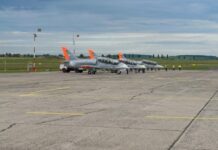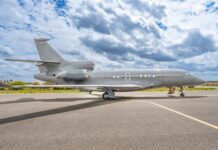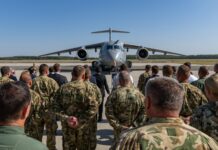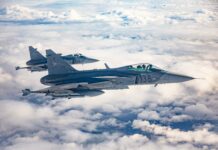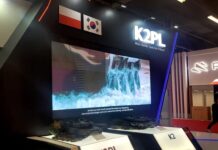According to Gáspár Maróth, the Hungarian Government Commissioner for Defence Development, the Hungarian Air Force will receive 12 L-39Next Generation (NG) aircraft from Czech aircraft manufacturer Aero Vodochody. The relevant contracts have reportedly already been put into effect. According to current plans, the light jet aircraft, designed as jet trainers, will be delivered in two versions by 2024. This should significantly improve the quality of pilot training and also create a new reconnaissance version, Maróth said and added that pilot training was one of the key elements of the Hungarian Government’s force development initiative (formerly known as Zrínyi 2026), which began in 2016.
Eight of the new aircraft will explicitly serve to fulfil this task. In addition to advanced training, the agile and comparatively small aircraft are also suitable to serve as operational trainers for the pilots of the JAS 39EBS HU. The Hungarian GRIPEN fleet was only geared up for the future at the end of last year by opting for the programme known as MS20 Block II and upgraded by the purchase of IRIS-T air-to-air missiles.
The real innovation in the current aircraft procurement is constituted by the remaining four L-39NGs. According to Maróth, these are to be developed into a yet-to-be-specified reconnaissance version within the framework of a joint Hungarian-Czech research initiative and will be available to the air forces at a later date.
L-39NG Background
The L-39NG is a development of the Aero L-39 ALBATROS two-seat, single-engine jet trainer and light attack aircraft and is available in two different versions.
The version designated L-39NG Stage 1 uses the old L-39 airframe and employs a new FJ44-4M engine, which, according to the manufacturer, provides a thrust of 16.87 kN and a top speed of 780 km/h. The L-39NG Stage 1 version is also equipped with the new FJ44-4M engine. In addition, the avionics package developed for the L-39NG Stage 2 can be retrofitted. Alongside a highly developed flight control system from US manufacturer Genesys Aerosystems and a digital fuel management system, this package is characterised by an open system architecture, which will also allow individual retrofitting and modernisation according to customer requirements in the future. This is presumably also the starting point for the development of the future reconnaissance version.
Aero Vodochody’s goal is to openly address the numerous L-39 users with the package and to offer a cost-effective development. The L-39NG Stage 2, which is the subject of the Hungarian procurement, is a completely new production effort with several design changes. For example, the latest version does away with the conventional tanks at the wingtips. Instead, the fuel is stored in the newly developed flat tanks, which results in an increase in the total volume and the associated range. The cabin roof has also been renewed and provides both crew members with a significantly better all-round view. Furthermore, proven Martin Baker Mk 16 ejection seats are installed. These are in use with the F-35 and Eurofighter TYPHOON with respective modifications. Thanks to five hardpoints, there are significantly more options for carrying external loads.
Wider Considerations
The procurement of the L-39NG is not a big surprise for industry insiders. In autumn 2021, it became known that the contract for the sale of Aero Vodochody had been concluded in July of the same year and that the new owner is the Hungarian company HSC Aerojet Zrt. According to media reports, the purchase was only possible thanks to a €150M backup from the Hungarian Development Bank, which required a Government resolution. The Hungarian Air Force’s existing interest in Aero Vodochody’s aircraft apparently continued to grow in the period that followed, and the L-39NG technology demonstrator was repeatedly spotted at Hungarian Air Force bases. The aircraft type, meanwhile, is not completely alien to the Hungarian Air Force. From 1993 onwards, Hungary received 24 L-39ZO from the former NVA stocks and, after an interim modernisation programme, operated them with declining numbers until mid-2010.








